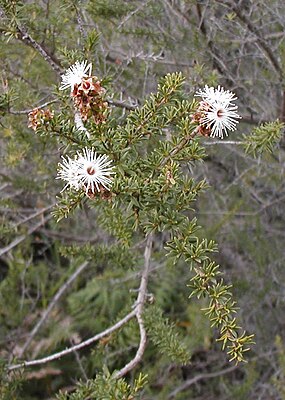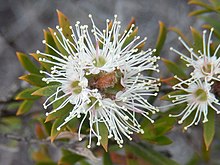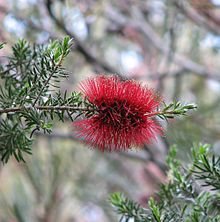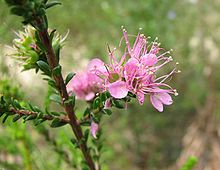Kunzea
| Kunzea | ||||||||||||
|---|---|---|---|---|---|---|---|---|---|---|---|---|

|
||||||||||||
| Systematics | ||||||||||||
|
||||||||||||
| Scientific name | ||||||||||||
| Kunzea | ||||||||||||
| Rchb. |
Kunzea is a genus of plants withinthe myrtle family (Myrtaceae). About 52 species originally come from Australia , ten species naturally occur in New Zealand .
description


Appearance and leaves
Kunzea species grow as evergreen shrubs or small trees that reach heights of 0.3 to 4 meters. They contain essential oils .
The alternate in most species, against constantly in a few species (see also epithet of Kunzea opposita ) on the branches arranged leaves are stalked or sitting. The herbaceous or leathery, simple leaf blades are hairy or glabrous, dotted with glands and have an aromatic smell. The leaf margins are smooth or serrated. There are no stipules .
Inflorescences and flowers
The mostly pseudo-terminal, head-like inflorescences contain more or less sessile flowers, more rarely the flowers are stalked and stand individually or in bundles in twos or threes in the leaf axils. The bracts are sometimes enlarged and form a shell (involucre). There are early sloping wrappers .
The relatively small, hermaphrodite flowers are radial symmetry and five-fold with a double flower envelope . The free, bald or hairy flower cup (hypanthium) is bell-shaped, usually broadly cup-shaped, or spherical to ovoid. The free area of the flower cup usually extends far beyond the upper end of the ovary. The five herbaceous sepals are green, ovate to triangular and at most as long as the petals. The five free, short nailed petals are flat, obovate to circular. The colors of the petals range from white to yellow and pink to purple. The stamens are so curved inward in the bud that the anthers are below the stigma. The many more or less the same (20 to 100) stamens are arranged in one or more circles, inserted in a ring on the flower cup and protrude above the petals. The thread-like stamens freely among each other and not fused with the petals. The same anthers are not upright, have two parallel counters and open with longitudinal slits. There is a discus . Usually two or three carpels are fused to form a two- or three- chamber ovary. A few hanging, anatropic ovules are arranged in the apical placentation or there is central-angled placentation with many anatropic ovules. The style is much longer than the ovary. The cephalic or shield-shaped (peltate) scar protrudes over the petals.
Fruits and seeds
The capsule fruits are mostly fissured = loculicidal, but they do not open in some species. The calyx is still present on the fruit. Only in Kunzea pomifera is the capsule fruit fleshy. The relatively small seeds do not contain any endosperm .
ecology
The pollination is done by insects ( Entomophilie ) or birds ( ornithophily ).





Systematics and distribution
The genus Kunzea was set up in Conspectus Regni Vegetabilis , p. 175 in 1828 . The generic name Kunzea honors the German naturalist Gustav Kunze (1793–1851), professor of botany in Leipzig . Synonyms for Kunzea Rchb. are: Pentagonaster Klotzsch , Salisia Lindl. , Stenospermum Sweet ex Heynh. , Tillospermum handle.
The genus Kunzea belongs to the tribe Leptospermeae in the subfamily Myrtoideae within the family Myrtaceae
All around 62 species originally come mainly from Australia , around ten species naturally also occur in New Zealand . On the Australian continent, species are found in all states, but most species in southern Western Australia . Several Kunzea species are neophytes in the Fynbos regions of South Africa .
There are around 62 Kunzea species (as of 2008 + then the first described species):
- Kunzea acicularis Toelken & GFCraig : This endemic occurs only in south-south- western Western Australia .
- Kunzea acuminata Toelken : This endemic occurs only in southern Western Australia.
- Kunzea affinis S.Moore : This endemic occurs only in southern Western Australia.
- Kunzea amathicola de Lange & Toelken : It wasfirst describedfrom New Zealand in 2014.
- Kunzea ambigua (Sm.) Druce : It occurs in Australia from New South Wales to Victoria and Tasmania .
- Kunzea aristulata Toelken : It was first described in 2016 from New South Wales.
- Kunzea axillaris Toelken : It was first described in 2016 from New South Wales.
- Kunzea badjaensis Toelken : It was first described in 2016 from New South Wales.
- Kunzea baxteri (Klotzsch) Schauer : This endemic occurs only in southwestern Australia.
- Kunzea bracteolata Maiden & Betche : It occurs in Australia from Queensland to New South Wales.
- Kunzea caduca Toelken : It was first described from Queensland in 2016.
- Kunzea calida F. Muell. : It occurs in Queensland.
- Kunzea cambagei Maiden & Betche : This endemic occurs only in east-central New South Wales.
-
Kunzea capitata (Sm.) Heynh. : There are two subspecies:
- Kunzea capitata (Sm.) Heynh. subsp. capitata : This endemic occurs only in eastern New South Wales.
- Kunzea capitata subsp. seminuda Toelken : It occurs in New South Wales.
- Kunzea ciliata Toelken : This endemic occurs only in southwestern Australia.
- Kunzea cincinnata Toelken : This endemic occurs only in southern Western Australia.
- Kunzea clavata Toelken : This endemic occurs only in southwestern Australia.
- Kunzea dactylota Toelken : It was first described in 2016 from New South Wales.
-
Kunzea ericifolia (Sm.) Heynh. : There are two subspecies:
- Kunzea ericifolia (Sm.) Heynh. subsp. ericifolia : This endemic only occurs in southwestern Australia.
- Kunzea ericifolia subsp. subulata Toelken : This endemic occurs only in southwestern Australia.
- Kunzea ericoides (A.Rich.) Joy Thomps. : It only occurs on the South Island of New Zealand.
- Kunzea eriocalyx F. Muell. : This endemic occurs only in southern Western Australia.
- Kunzea flavescens C.T.White & WDFrancis : This endemic occurs only in southeast Queensland.
- Kunzea glabrescens Toelken : This endemic occurs only in southwestern Australia.
- Kunzea graniticola Byrnes : This endemic occurs only in northeast Queensland.
- Kunzea jucunda Diels & E. Pritz. : This endemic occurs only in southern Western Australia.
-
Kunzea juniperoides Toelken : The two subspecies occur only in New South Wales:
- Kunzea juniperoides toelken subsp. juniperoides
- Kunzea juniperoides subsp. pernervosa Toelken
- Kunzea leptospermoides F. Muell. ex Miq. : This endemic occurs only in southern Victoria.
- Kunzea linearis (Kirk) de Lange & Toelken : It occurs only on the North Island of New Zealand.
-
Kunzea micrantha shower :. The four subspecies are only found in southwestern Australia:
- Kunzea micrantha shower subsp. hirtiflora toelken
- Kunzea micrantha shower subsp. micrantha
- Kunzea micrantha subsp. oligandra (Turcz.) Toelken
- Kunzea micrantha subsp. petiolata Toelken : It occurs in west-southwest Western Australia.
- Kunzea micromera Schauer : This endemic occurs only in southwestern Australia.
- Kunzea montana (Diels) Domin : This endemic occurs only in southwestern Australia.
- Kunzea muelleri Benth. : It occurs in Australia from southeastern New South Wales to northeastern Victoria.
- Kunzea newbeyi Toelken : This endemic occurs only in southwestern Australia.
- Kunzea obovata Byrnes : southern Queensland to northern New South Wales.
- Kunzea occidentalis Toelken : It was first described in 2016 from New South Wales.
- Kunzea opposita F. Muell. : The two varieties are only found in eastern Australia.
- Kunzea parvifolia Schauer : It occurs in Australia from New South Wales to Victoria.
- Kunzea pauciflora Schauer : This endemic occurs only in southern Western Australia.
- Kunzea peduncularis F. Muell. : This endemic occurs only in eastern Victoria.
- Kunzea petrophila Toelken : It was first described in 2016 from the Northern Territory.
- Kunzea phylicoides (A.Cunn. Ex Schauer) Druce : This endemic occurs only in southeastern Australia.
- Kunzea pomifera F. Muell. : Southeast South Australia to western Victoria.
- Kunzea praestans Schauer : This endemic occurs only in west-southwestern Western Australia.
- Kunzea preissiana Schauer : This endemic occurs only in southwestern Australia.
- Kunzea pulchella (Lindl.) ASGeorge : This endemic occurs only in southwestern Australia.
- Kunzea recurva Schauer : This endemic occurs only in southwestern Australia.
- Kunzea robusta de Lange & Toelken : It was first described in 2014 and occurs on New Zealand's North and South Island.
- Kunzea × rosea (Turcz.) Govaerts = Kunzea juncea × Kunzea preissiana : Southern Western Australia.
- Kunzea rostrata Toelken : This endemic occurs only in southwestern Australia.
- Kunzea rupestris Blakely : It occurs in New South Wales.
- Kunzea salina (Trudgen & Keighery) Toelken & de Lange : Southwest Australia.
- Kunzea salterae de Lange : It was first described in 2014 and occurs only on the North Island of New Zealand.
- Kunzea sericothrix Toelken : It was first described from Queensland in 2016.
- Kunzea serotina de Lange & Toelken : It was first described in 2016 and occurs on New Zealand's North and South Island.
-
Kunzea similis Toelken :. The two subspecies are only found in southern Western Australia:
- Kunzea similis subsp. mediterranea Toelken & GFCraig
- Kunzea similis Toelken subsp. similis
- Kunzea sinclairii (Kirk) W.Harris : It occurs only on the North Island of New Zealand.
- Kunzea spathulata Toelken : Southwest Australia.
- Kunzea × squarrosa Turcz. = Kunzea montana × Kunzea recurvata : Southwest Australia.
- Kunzea strigosa Toelken & GFCraig : This endemic occurs only in south-south-western Western Australia.
- Kunzea sulphurea Tovey & P.Morris : This endemic occurs only in southwestern Australia.
- Kunzea tenuicaulis de Lange : It was first described in 2014 and occurs on New Zealand's North Island.
- Kunzea toelkenii de Lange : It was first described in 2014 and occurs on New Zealand's North Island.
- Kunzea triregensis de Lange : It wasfirst describedin 2014 by the New Zealand Three Kings Islands .
- Kunzea truncata Toelken : It was first described from Queensland in 2016.
There are hybrids between all species that are common in one area. This complicates the determination and systematics.
Individual evidence
- ↑ a b c d e f g h i Peter G. Wilson: Entry in the New South Wales Flora Online . last accessed on January 10, 2013
- ↑ a b c d e f g Entry in the Western Australian Flora . last accessed on January 10, 2013
- ^ Kunzea at Tropicos.org. Missouri Botanical Garden, St. Louis, accessed January 10, 2013.
- ↑ Entry at Australian Plant Name Index = APNI. last accessed on January 10, 2013
- ↑ Lotte Burkhardt: Directory of eponymous plant names - Extended Edition. Part I and II. Botanic Garden and Botanical Museum Berlin , Freie Universität Berlin , Berlin 2018, ISBN 978-3-946292-26-5 doi: 10.3372 / epolist2018 .
- ^ Kunzea in the Germplasm Resources Information Network (GRIN), USDA , ARS , National Genetic Resources Program. National Germplasm Resources Laboratory, Beltsville, Maryland. Retrieved January 10, 2013.
- ↑ a b c d e f g h i j k l m n o p q r s t u v w x y z aa ab ac ad ae af ag ah ai aj ak al am an ao ap aq ar as at au av aw ax ay az ba bb bc bd be bf bg bh bi bj bk bl bm bn bo bp bq br Rafaël Govaerts, N. Sobral, P. Ashton, F. Barrie, BK Holst, LL Landrum, K. Matsumoto, F. Fernanda Mazine , E. Nic Lughadha, C. Proenca et al. 2008: World Checklist of Myrtaceae : 1-455. Kew Publishing, Royal Botanic Gardens, Kew. Rafaël Govaerts (Ed.): Kunzea. In: World Checklist of Selected Plant Families (WCSP) - The Board of Trustees of the Royal Botanic Gardens, Kew . Retrieved May 1, 2020.